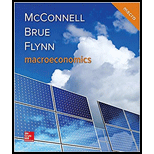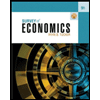
Changes in Equilibrium GDP .
Explanation of Solution
Table -1
|
(1) Real domestic output |
(2) Aggregate expenditure, private closed economy |
(3) Export (in billions) |
(4) Import (in billions) |
(5) Net export (in billions) Private closed economy |
(6) Aggregate Expenditure (in billions), open economy |
| $200 | $240 | $20 | $30 | -$10 | $230 |
| $250 | $280 | $20 | $30 | -$10 | $270 |
| $300 | $320 | $20 | $30 | -$10 | $310 |
| $350 | $360 | $20 | $30 | -$10 | $350 |
| $400 | $400 | $20 | $30 | -$10 | $390 |
| $450 | $440 | $20 | $30 | -$10 | $430 |
| $500 | $480 | $20 | $30 | -$10 | $470 |
| $550 | $500 | $20 | $30 | -$10 | $510 |
The net export can be calculated by using the following formula.
Substitute the respective values in Equation (1) to calculate the net export at the real output $200.
The net export is -$10 billion.
The aggregate expenditure (AE) of open economy can be calculated by using the following formula.
Substitute the respective values in Equation (1) to calculate the aggregate expenditure at the real output $200.
The aggregate expenditure of open economy is $230 billion.
Table -2 shows the value of net export and aggregate expenditure of open economy that obtained by using equation (1) and (2).
Table -1
|
(1) Real domestic output |
(2) Aggregate expenditure, private closed economy |
(3) Export (in billions) |
(4) Import (in billions) |
(5) Net export (in billions) Private closed economy |
(6) Aggregate Expenditure (in billions), open economy |
| $200 | $240 | $20 | $30 | -$10 | $230 |
| $250 | $280 | $20 | $30 | -$10 | $270 |
| $300 | $320 | $20 | $30 | -$10 | $310 |
| $350 | $360 | $20 | $30 | -$10 | $350 |
| $400 | $400 | $20 | $30 | -$10 | $390 |
| $450 | $440 | $20 | $30 | -$10 | $430 |
| $500 | $480 | $20 | $30 | -$10 | $470 |
| $550 | $500 | $20 | $30 | -$10 | $510 |
Multiplier can be calculated as follows.
The multiplier is 5.
Given the multiplier, the marginal propensity to consume (MPC) is calculated as follows,
The marginal propensity to consume is 0.8.
From table 1, before the addition of government expenditure (G), the open private sector equilibrium is at $350 billion.
When the government expenditure of $20 billion is added, the AE increases and increases the equilibrium level of GDP. Due to the multiplier effect, the equilibrium GDP increases by $100 billion
Whereas, the $20 billion increase in taxes initially reduces consumption by $16 billion
Thus, the net change from this balance between the government spending and taxes is $20 billion
Concept Introduction:
Aggregate Expenditure (AE): It is the total value of spending in the economy during a period of time at given price level.
Equilibrium gross domestic product (GDP): Equilibrium GDP occurs at the point where the aggregate expenditure equals to the real domestic output.
Multiplier effect: It describes how an injection to the economy via increase in government spending, investment spending, consumer spending and so forth create a ripple effect in the real output (increase) of the economy.
Marginal Propensity to Consume (MPC): It measures the amount of disposable income that consumers are willing to spend on goods and services.
Want to see more full solutions like this?
Chapter 11 Solutions
MACROECONOMICS (LL)
- Use the Feynman technique throughout. Assume that you’re explaining the answer to someone who doesn’t know the topic at all. Write explanation in paragraphs and if you use currency use USD currency: 10. What is the mechanism or process that allows the expenditure multiplier to “work” in theKeynesian Cross Model? Explain and show both mathematically and graphically. What isthe underpinning assumption for the process to transpire?arrow_forwardUse the Feynman technique throughout. Assume that you’reexplaining the answer to someone who doesn’t know the topic at all. Write it all in paragraphs: 2. Give an overview of the equation of exchange (EoE) as used by Classical Theory. Now,carefully explain each variable in the EoE. What is meant by the “quantity theory of money”and how is it different from or the same as the equation of exchange?arrow_forwardZbsbwhjw8272:shbwhahwh Zbsbwhjw8272:shbwhahwh Zbsbwhjw8272:shbwhahwhZbsbwhjw8272:shbwhahwhZbsbwhjw8272:shbwhahwharrow_forward
- Use the Feynman technique throughout. Assume that you’re explaining the answer to someone who doesn’t know the topic at all:arrow_forwardUse the Feynman technique throughout. Assume that you’reexplaining the answer to someone who doesn’t know the topic at all: 4. Draw a Keynesian AD curve in P – Y space and list the shift factors that will shift theKeynesian AD curve upward and to the right. Draw a separate Classical AD curve in P – Yspace and list the shift factors that will shift the Classical AD curve upward and to the right.arrow_forwardUse the Feynman technique throughout. Assume that you’re explaining the answer to someone who doesn’t know the topic at all: 10. What is the mechanism or process that allows the expenditure multiplier to “work” in theKeynesian Cross Model? Explain and show both mathematically and graphically. What isthe underpinning assumption for the process to transpire?arrow_forward
- Use the Feynman technique throughout. Assume that you’re explaining the answer to someone who doesn’t know the topic at all: 15. How is the Keynesian expenditure multiplier implicit in the Keynesian version of the AD/ASmodel? Explain and show mathematically. (note: this is a tough one)arrow_forwardUse the Feynman technique throughout. Assume that you’re explaining the answer to someone who doesn’t know the topic at all: 13. What would happen to the net exports function in Europe and the US respectively if thedemand for dollars rises worldwide? Explain why.arrow_forward20. Given the mathematical model below, solve for the expenditure multiplier for a) government spending, G; and b) for consumer taxes, T. (medium difficulty) Y=C+I+G C=Co+b(Y-T) 1 = 10 T=To+tY G = Go+gYarrow_forward
- Use the Feynman technique throughout. Assume that you’re explaining the answer to someone who doesn’t know the topic at all: 11. What exactly is a rectangular hyperbola and what relevance is it to classical economics?arrow_forwardUse the Feynman technique throughout. Assume that you’re explaining the answer to someone who doesn’t know the topic at all: 9. Explain the difference between absolute and comparative advantage in a family setting, i.e.using parents and children. What can we glean from knowing about comparative andabsolute advantages?arrow_forwardUse the Feynman technique throughout. Assume that you’re explaining the answer to someone who doesn’t know the topic at all: 18. Explain why most economists believe it is absolutely necessary to allow free trade in aneconomy. Why is it harmful (under most circumstances) to have tariffs and trade barriers?arrow_forward




 Survey of Economics (MindTap Course List)EconomicsISBN:9781305260948Author:Irvin B. TuckerPublisher:Cengage Learning
Survey of Economics (MindTap Course List)EconomicsISBN:9781305260948Author:Irvin B. TuckerPublisher:Cengage Learning Economics (MindTap Course List)EconomicsISBN:9781337617383Author:Roger A. ArnoldPublisher:Cengage Learning
Economics (MindTap Course List)EconomicsISBN:9781337617383Author:Roger A. ArnoldPublisher:Cengage Learning





